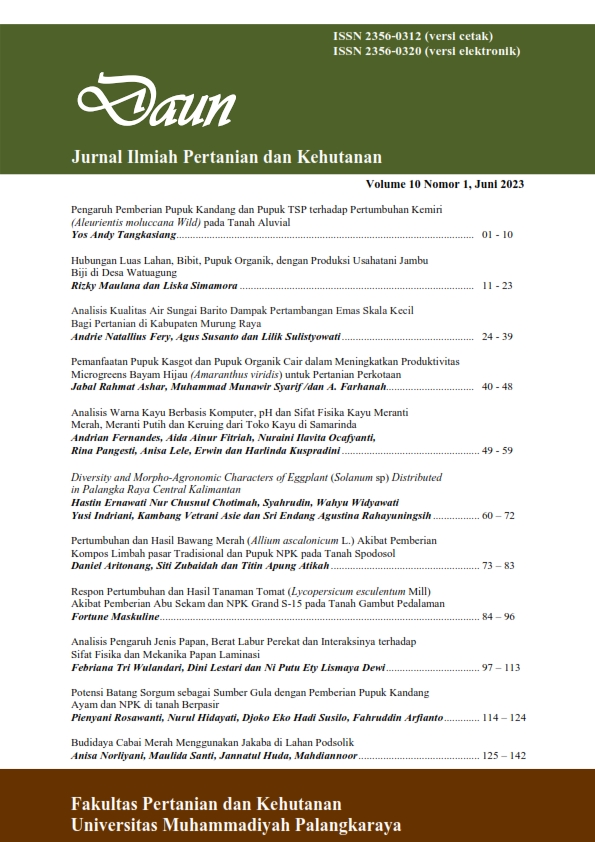Diversity and morpho-agronomic characters of eggplant (Solanum sp) distributed in Palangka Raya Central Kalimantan
Main Article Content
Abstract
The eggplant species are currently at risk of extinction due to various factors such as land conversion into plantation areas and transmigration settlements in Palangka Raya. It is essential to conduct a thorough analysis of eggplant vegetation to address this urgent matter. Consequently, the research aimed to determine the diversity of eggplants, their distribution, as well as their morpho-agronomic characters. Field experiments were carried out in each district of Palangka Raya for 7 months. The methods used were survey, exploration, and interview with the key informant. Plant characterization refers to the descriptors for eggplant (IBPGR, 1990). The observed variables were the morphological characterization of eggplant, agronomy, and the distribution of eggplant in Palangka Raya. Results showed that it is found three species of eggplants, namely Solanum melongena (ungu, gelatik, telur, apel hijau eggplant cultivars), Solanum torvum, and Solanum ferox. There was variation in the morpho-agronomic characters of eggplant found.
Downloads
Article Details

This work is licensed under a Creative Commons Attribution-ShareAlike 4.0 International License.
All rights reserved. This publication may be reproduced, stored in a retrieval system, or transmitted in any form or by any means, electronic, mechanical, photocopying, recording.
References
(Balitbangtan) Badan Penelitian dan Pembangunan Pertanian, 2018. Koleksi dan Kajian Etno-botanik Terung (Solanum melongena) dan Kerabat Liarnya. www.litbang.pertanian.go.id (diakses pada tanggal 17 Maret 2019
(IBPGR) International Board for Plant Genetic Resources.1990. Descriptors for eggplant. International Board for Plant Genetic Resources 23 p.
Bean AR. 2004. The taxonomy and ecology of Solanum subg. Leptostemonum (Dunal) Bitter (Solanaceae) in Queensland and far north-eastern New South Wales, Australia. Austrobaileya 6: 639–816.
Bello, A.O., Oladipo, O.T., Saheed, S.A., 2013. Numerical taxonomic study of some Solanum L. species (Solanaceae) using vegetative and floral morphological characters. Ife J. Sci. 15 (3), 523–534
Campbell, N.A., Reece, J.B., & Mitchell, L.G. .2003. Biologi. Jilid 2. Edisi Kelima. Alih Bahasa: Wasmen. Jakarta: Penerbit Erlangga.
Choudhary, B. and Gaur, K. 2009. The Development and Regulation of Bt Brinjal in India. ISAAA Brief No. 38, International Service for Acquisition of Agri-Biotech Applications, Ithaca, NY.
CIAT. 1993. Biotechnology Research Unit. Annual Report, Cali, Colombia International Potato Centre (CIP), Asian Vegetable Research and Development Centre (AVRDC), International Board for Plant Genetic Resources (IBPGR), 1991. In: Z. Huaman (ed.), Descriptors for Sweet Potato, pp: 43–130. IBPGR, Rome, Italy
Faidah, A. Waluyo, B. Ashari, S. 2020. Diversity of agronomic and morphological characters of F1 (Solanum melongena) double cross. Jurnal Produksi Tanaman Vol. 8 No. 12. 1090-1098
Fatima, de.,Maria. 2007. Diversity and Distribution of Solanum subg. Leptostemonum in Brazil. International Solanaceae Conference, Brazil.
Fawzi, N. M., & Habeeb, H. R. (2016). Taxonomic study on the wild species of genus Solanum L. in Egypt. Annals of Agricultural Science, 61, 165-173
Grubben, G. J. H. and S. Sukprakarn. 1994. Plant Resourches of South-East Asia No 8 Vegetables. PROSEA. Bogor, Indonesia.
Hadiatna, E. 2010. Mari Kita Bercocok Tanam Terong Jepang. PT Sinergi Pustaka Indonesia. Bandung. 62 hal
Hanson, P., R.Y. Yang., S.C.S. Tsou., D. Ledesma., L. Engle., and T.C. Lee. 2006. Diversity in Eggplant (Solanum melongena) for Superoxide Scavenging Activity, Total Phenolics, and Ascorbic acid. Journal of Food Composition and Analysis 19(6-7): 594-600
Hasan, S.M.Y and Jansen, P.C.M. 1993. Solanum L. In: Vegetables in Wageningen: Pudoc (PROSEA 8) - p. 249 - 252.
Hepper, F.N., 2002. Solanaceae. Flora of Egypt (Verbenaceae-Compositae), vol. 3. Al Hadara Publishing, Cairo, pp. 34–54
Jennifer, M.E., James, A.C., 1997. Black Nightshades, Solanum nigrum L. and Related Species. IPGRI, Italy
Li, P., Y. Yunwen, X. Sun, and J. Han. 2009. Using microsatellite (SSR) and morphological markers to assess the genetic diversity of 12 falcata (Medicago sativa spp. falcata) population from Eurasia. Afr. J.Biotechnol. 8(10): 2102-2108
Maskromo, I. & Miftahorrachman, 2007. Keragaman genetik plasma nutfah pinang (Areca catechu L.) di Provinsi Gorontalo. Jurnal Penelitian Tanaman Industri 13(4): 119-124.
Rimoldi, F., P.D.V. Filho, M.V. Kvitschal, M.C. Gonzalvesvidigal, A.J. Prioli, S.M.A.P. PRIOLI, and T.R. Da Costa. 2010. Genetic divergence in sweet cassava cultivars using morphological agronomic traits and RAPD molecular markers. Braz. Arch. Biol. Technol. 53(6): 1447-1487.
Rubatzky V. E dan M. Yamaguchi. 1999. World Vegetables Principles, Production and Nutrictive Value, 2 nd ed. Chapman and Hall. USA. 83p.
Sirait, B.N. 2009. Terong cepoka (Solanum torvum Sw.) herba yang berkhasiat sebagai obat. Warta Penelitian Dan Pengembangan Tanaman Industri, Volume 15 Nomor 3, Desember 2009, 15, 10–12
Talebi, R., F. Fayaz, M. Mardi, S. M. Pirsyedi, and A.M. Naji. 2008. Genetic relationships among chickpea (Cicer arietinum) elite lines based on RAPD and agronomic markers. Int. J. Agri. Biol. 10(3): 301-305
